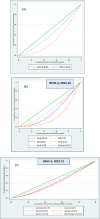Socio-economic disparities in the utilization of improved sanitation facilities among Indian households
- PMID: 39738319
- PMCID: PMC11685393
- DOI: 10.1038/s41598-024-80949-3
Socio-economic disparities in the utilization of improved sanitation facilities among Indian households
Abstract
Despite the significant improvement in sanitation coverage , utilization of improved sanitation still does not reach the optimal level across all socioeconomic groups in India. Therefore, achieving improved sanitation facilities and reducing all forms of inequality United Nations Sustainable Development Goal [SDG 6.2] by 2030 is a big challenge to the most populous country in the world. Given this backdrop, this study examines the socioeconomic status-related inequality in the utilization of improved sanitation facilities among Indian Households. The study utilized fifth round of National Family Health Survey (NFHS); a national representative cross-sectional survey of India conducted in 2019-2021. Logistic regression was applied to estimate the effect of various predictors on utilization of improved sanitation facilities. We also used decomposition analyse to identify the factors responsible for utilization of improved sanitation. The results indicate that 69% of Indian households utilized improved sanitation facilities. The study highlights that young and unmarried household heads, lower education, poor household wealth status, living in rural areas, and marginalized social groups had lower access to improved sanitation facilities. The multivariate regression analysis suggested that households belonging to richer [AOR: 14.0; 95%, CI: 13.6-14.3] and richest [AOR: 46.7; 95%, CI: 45.0-48.5] wealth quintiles have 14 and 47-times higher odds of having sanitation facility than households which belong to poorest quintile respectively. The decomposition analysis suggested that 11 to 18% of inequality was explained by the geographical region and social group of household heads. The concentration curve of utilization of improved sanitation was more concentrated in Central and Eastern part of Indian households (Concentration Index: 0.51 and 0.47), which has reduced to 0.17 and 0.22 during NFHS-4 to NFHS-5. We also found that 68 districts out of 707 districts in India had less than 50% utilization of improved sanitation facilities. The study concludes that households with a better socioeconomic status were more able to access improved sanitation. Thus, inclusive strategies are needed to reduce socioeconomic inequality at the micro level and strengthen ongoing policies.
Keywords: Concentration index; Improved sanitation; India; Socio-economicinequality.
© 2024. The Author(s).
Conflict of interest statement
Declarations. Competing interests: The authors declare no competing interests. Consent for publication: All authors approved the final manuscript and the submission to this journal.
Figures



Similar articles
-
Wealth-based inequalities in tuberculosis prevalence among households having children and young adults in India: insights from Indian demographic and health surveys (2015-2021).BMC Infect Dis. 2025 Jan 4;25(1):21. doi: 10.1186/s12879-024-10301-7. BMC Infect Dis. 2025. PMID: 39755594 Free PMC article.
-
Spatial distribution and determinants of improved shared sanitation facilities among households in Ethiopia: Using 2019 mini-Ethiopian Demographic and Health Survey.PLoS One. 2025 Jan 13;20(1):e0315860. doi: 10.1371/journal.pone.0315860. eCollection 2025. PLoS One. 2025. PMID: 39804838 Free PMC article.
-
Correlates of access to sanitation facilities and benefits received from the Swachh Bharat Mission in India: analysis of cross-sectional data from the 2018 National Sample Survey.BMJ Open. 2022 Jul 29;12(7):e060118. doi: 10.1136/bmjopen-2021-060118. BMJ Open. 2022. PMID: 35906052 Free PMC article.
-
Dr. Suhas Vitthal Mapuskar: A Pioneer in Rural Sanitation in Maharashtra, India.Cureus. 2025 Jan 28;17(1):e78124. doi: 10.7759/cureus.78124. eCollection 2025 Jan. Cureus. 2025. PMID: 40026968 Free PMC article. Review.
-
User-Centered Guidance for Engineering and Design of Decentralized Sanitation Technologies.2018 Jun. In: RTI Press Research Brief [Internet]. Research Triangle Park (NC): RTI Press; 2014–. 2018 Jun. In: RTI Press Research Brief [Internet]. Research Triangle Park (NC): RTI Press; 2014–. PMID: 32119392 Free Books & Documents. Review.
References
-
- The World Bank. Sanitation. https://www.worldbank.org/en/topic/sanitation (2023).
-
- World Health Organization & United Nations Children’s Fund (UNICEF).Progress on Drinking Water, Sanitation and Hygiene: 2017 Update and SDG Baselines. https://iris.who.int/handle/10665/2586173 (2017).
-
- United Nations. The Sustainable Development Goals Report Special Edition. https://unstats.un.org/sdgs/report/2023/The-Sustainable-Development-Goal... (2023).
-
- World Health Organization. Sanitation. https://www.who.int/news-room/fact-sheets/detail/sanitation (2024).
-
- The Economic and Social Commission for Asia and the Pacific. Asia and the Pacific SDG Progress Report Showcasing Transformative Actions 2024. https://repository.unescap.org/handle/20.500.12870/6659 (2024).
MeSH terms
LinkOut - more resources
Full Text Sources

